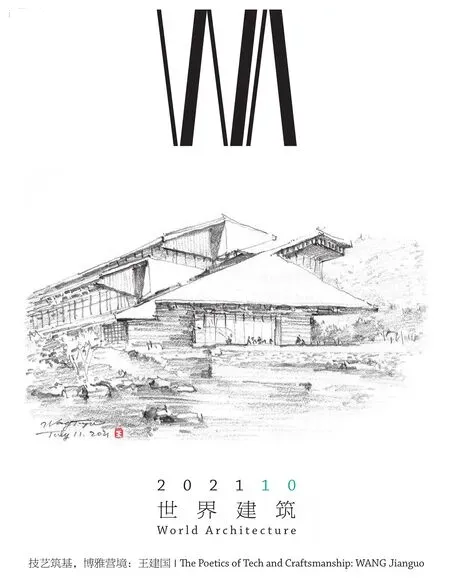上海轨交16号线周浦东站07-05地块配套小学,上海,中国
该项目为上海轨交16号线周浦东站地区的社区配套文教设施之一,位于韵涛路以北,六灶港河以南,周泰路以东,周秀路以西,三面临路交通便捷,且具有较佳的临河景观资源,区位优势显著。该小学具备30班规模,建成后可容纳约1200名学生就读。
成长之树
方案从校园空间的营造入手,营造立体化、网络化的共享空间和活动场所,为学生提供多样化的空间类型和场所体验。将建筑沿道路布置,可以最大程度地保证对中心河道与自然景观的开敞。动感的建筑形体和绿化景观,形成公共空间的整体流动性,充分引入自然,使校园与自然共同成长。
共享之台
建筑形体上下分层,形成连成一体的共享平台,并将学校的各公共功能在地面以及地上二层联系起来。共享平台除了连接教学楼外,还集合了多种公共功能,如德育展厅、图书馆、看台等,平台空间结合前厅、开放走廊、大台阶、公共楼梯等,创造出丰富的空间形态。
活力之园
教学与实验等功能充分满足日照与景观要求,与共享平台形成有机整体,并创造出大小不一、尺度各异的活动场地与绿化庭院,增加了教学场所的空间体验并改善教学区域的微环境。利用共享平台布置木质看台,成为联系教学用房与风雨操场的纽带。利用适宜儿童体验的家具、小品等营造活泼的空间氛围,为学生提供了丰富的课余活动场所,满足了小学生的心理行为特点和好奇心理。
江南之韵
建筑造型设计力求现代简洁,避免过度文饰。为提高建筑本体的表现力度,主体部分采用白色饰面砂浆和青砖肌理,局部设置单坡和双坡屋顶,营造兼具传统意蕴与现代建筑气质的当代江南之韵。在不同教学单元间采用彩色装饰,形成明快活泼的教学氛围,同时间隔搭配穿孔铝板及铝合金格栅,组合成富有韵律的开放界面。西侧共享廊道结合活动空间形成空中绿化庭院,在丰富空间的同时也提升了建筑的绿色生态性能。□

1 东南鸟瞰/Southeast aerial view
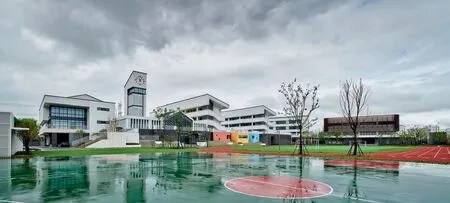
2 从操场看校园建筑群/View of the campus buildings from the playground(1.2摄影/Photos: 陈颢/CHEN Hao)
This project is one of the educational facilities for the community of East Zhoupu Station area of Shanghai Rail Line 16, which is located to the north of Yuntao Road, the south of Liuzaogang River, the east of Zhoutai Road and the west of Zhouxiu Road. It features convenient road traffic and pleasant riverside landscape resources, highlighting obvious geographical advantages.The primary school is designed to fit 30 classrooms and is expected to accommodate up to 1200 students.
The Tree of Growth
The scheme starts with the construction of the campus space by creating three-dimensional shared space and activity venue that provide students with diversified space and experience. The architectural layout along the roads can ensure the openness of the river and natural landscape to the greatest extent. With dynamic architectural form and landscape, the overall mobility of public space is obtained, making the campus evolve with nature.
The Platform for Sharing
The building is layered vertically to form an integrated platform for sharing, connecting the public functions of different floors. In addition to connecting the classrooms, the platform also integrates a variety of public functions, such as education exhibition hall, library, stadium,grandstand, etc. The platform space combines the front hall, open corridor, grand steps, public stairs,etc., creating a vivid and diverse spatial form.
The Garden of Vitality
The teaching and experiment facilities fully meet the sunlight exposure and landscape view requirements, forming an organic whole with the platform for sharing. Activity venues and green courtyards with different sizes and scales have also been established, not only enhancing the spatial experience of teaching areas but also improving the micro-environment within it. Putting the psychological and behavioural characteristics as well as the students' curiosity into consideration,furniture and installations suitable for children are used to create a lively atmosphere and provide students with rich extracurricular activities.
The Glamour of Jiangnan Area
The architectural design is modern and concise, not only avoiding excessive decoration but also showing greater emphasis on the building's expression. The main surface adopts white decorative mortar and grey bricks, with partial single-sloped and double-sloped roofs, creating the contemporary glamour of Jiangnan area,incorporating both its traditional implication and modern architectural style. Colour-based decorations are employed for different teaching units to form a lively teaching atmosphere. At the same time,perforated aluminium plates and aluminium alloy grilles are matched at intervals to form a rhythmic open interface. Furthermore, the common corridor on the west side is combined with the activity space to form a suspended green courtyard, which not only enriches the space but also enhances the green ecological performance of the building.□
项目信息/Credits and Data
设计团队/Design Team: 王建国,蒋楠,王小嘉,沈宇驰,吕明扬等/WANG Jianguo, JIANG Nan, WANG Xiaojia SHEN Yuchi, LYU Mingyang, et al.
建筑面积/Floor Area: 16,300 m2
设计时间/Design Period: 2015-2018
竣工时间/Completion Time: 2021
摄影/Photos: 陈颢,王建国,张雷/CHEN Hao, WANG Jianguo, ZHANG Lei
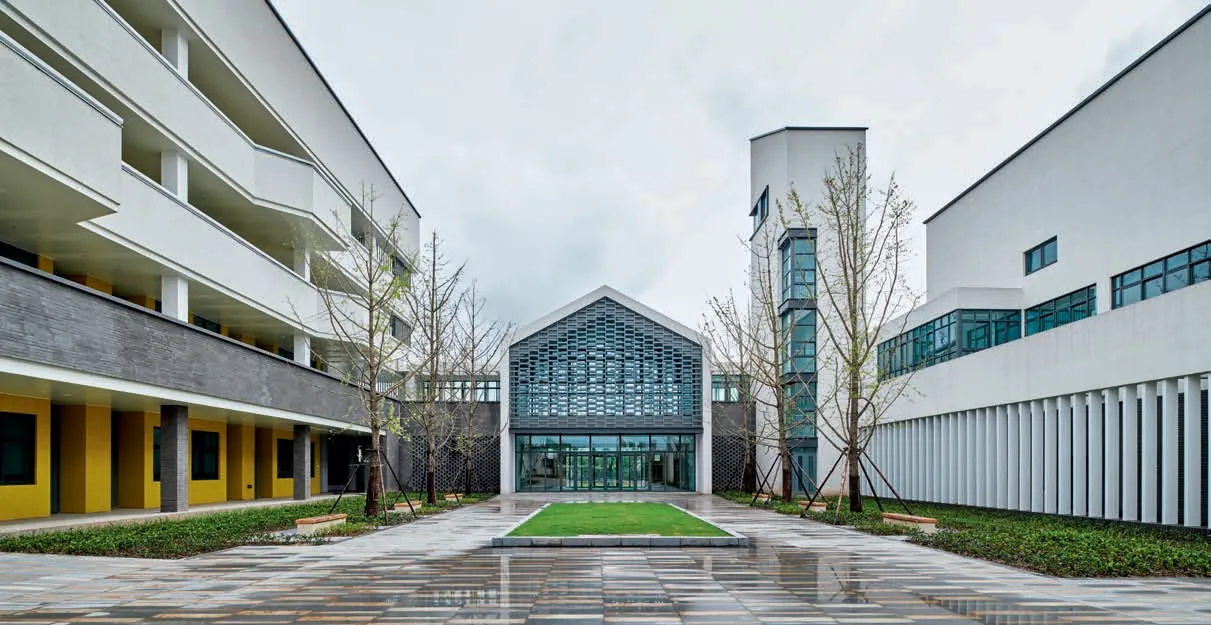
3 校园主入口/Main entrance(摄影/Photo: 陈颢/CHEN Hao)
评论
李翔宁:上海轨交16号线周浦东站07-05地块配套小学位于上海浦东新区南部。16号线周浦东站位于南北向的沪奉高速公路沿线,东侧为新近建成的上海国际医学园区,西侧规划以生活区为主。项目场地位于轨交站点西侧500m,场地周边仍处于开发状态,与西侧周浦镇中心区也有一定距离。因此,与嵌入城市地块并尊重场地文脉的情况不同,该项目在设计之初所能参照的场地要素大多是缺席的。城市肌理的断裂与城市形态的空白导致了外部条件的相对无效性,使其既迟疑于新的社会文化的发生,也很难在短时间内建立起人们对地方及其文化身份的认同,这同样是许多中国建筑师在设计新城开发地块时常常面对的情况。场地的“白板”状态,或许曾在勒·柯布西耶的“光辉城市”中所热望,却更是哲学家洛克提出的“白板”认知论的现实映射。
如何在近于空白的场地中建立建筑,并由此使人积累起与场所有关的感觉与经验?王建国院士的选择是建构一种具有自主性的空间秩序:根据现有的道路条件,建筑师在场地西侧与北侧组织L形的连续界面,主动介入新的城市界面的塑造。从城市设计的功能视角出发,结合教学、运动、辅助区块的不同组织关系与条形教学楼平面,围合出3个相对独立的庭院空间。大小各异、疏落有致的景观绿地点缀其中,构建互相渗透的连续关系。建筑集中于场地西侧布置,庭院为空间使用者提供良好的观景视野,释放出的东侧场地则作为多种类型的运动场,并与周边即将建成的城市环境预留出适配与协调的空间。建筑由此为场地建立了一处向心性的锚点。
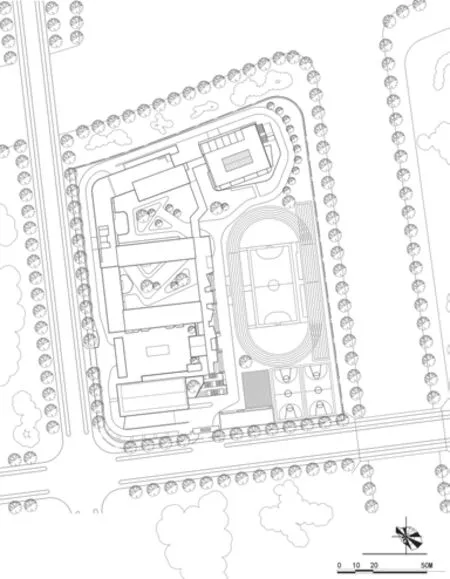
4 总平面/Site plan

5 首层平面/Ground floor plan

6 剖面/Section
Comments
LI Xiangning: The primary school on block 07-05 of East Zhoupu Station of Shanghai Rail Line 16 is situated in the southern part of Shanghai Pudong New District, along the north-south Shanghai-Fengxian Expressway, with the newly built Shanghai International Medical Park to the east and the living area to the west, 500 metres west of the rail line station. The surrounding area is under development,and the site is also quite distant from the central area of Zhoupu Town to the west. Therefore, other than having to respect the urban context, the elements that can be used as reference for the design were mostly absent. The lack of urban fabric and urban form led to relatively inefficient external conditions, making it indifferent to the occurrence of new social cultures and difficult to establish people's identity with the place and its culture. This is the typical situation that many Chinese architects often face in new development plots. The "Tabula rasa" state may be an aspiration in Le Corbusier' s "Ville Radieuse", but in this case is more likely a realistic reflection of the original theory proposed by the philosopher John Locke .
How to build a building in a nearly blank site, and thus enable people to accumulate sense and experience of the place? WANG Jianguo's choice is to construct an autonomous spatial order —— according to the existing road conditions, the architect organised an L-shaped continuous edge on the west and north side of the site,and actively intervened in shaping new urban interface.From the functional perspective of urban design,the different organisational relationships among the teaching, sports, and auxiliary blocks are fully explored,and three relatively independent courtyard spaces are enclosed in consideration of the bar-shaped teaching building plan. The various and well-proportioned green landscapes are scattered among them, constructing a continuous relationship of mutual penetration. The buildings are arranged on the west side of the site,and the courtyard provides a good view for the users.The east part is planned as various sports fields, and is reserved for adaptation and coordination with the surrounding urban environment to be built. The buildings thus set up a central point for the site.
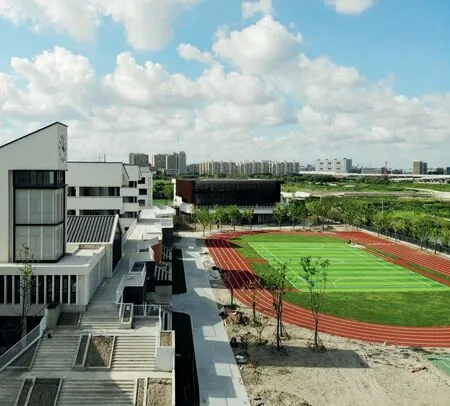
7 鸟瞰/Aerial view
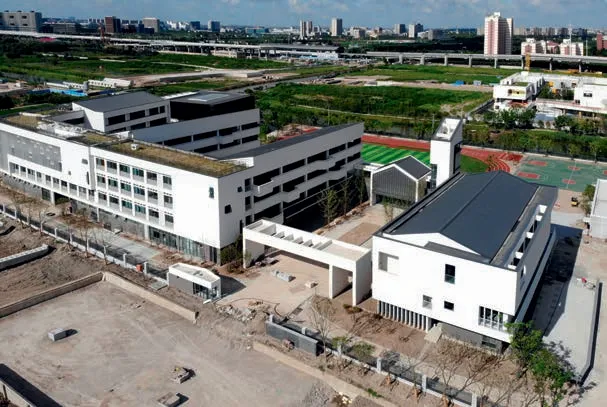
8 入口鸟瞰/Aerial view of entrance(7.8摄影/Photos: 张雷/ZHANG Lei)
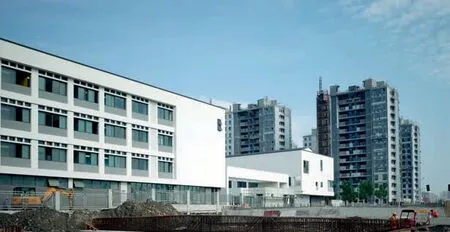
9 沿街立面/View from the street(摄影/Photo: 王建国/WANG Jianguo)

10 风雨操场/Gymnasium
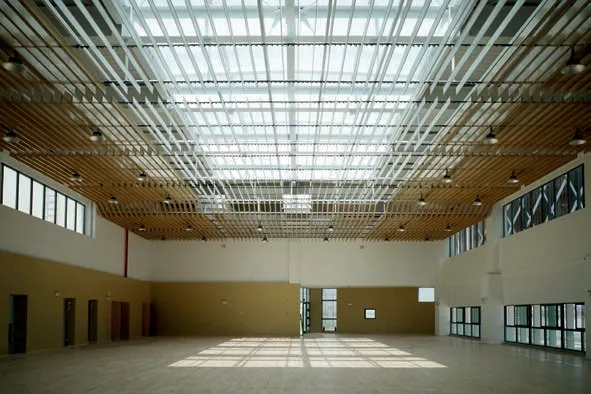
11 风雨操场室内/Interior view of Gymnasium(10.11摄影/Photos: 王建国/WANG Jianguo)
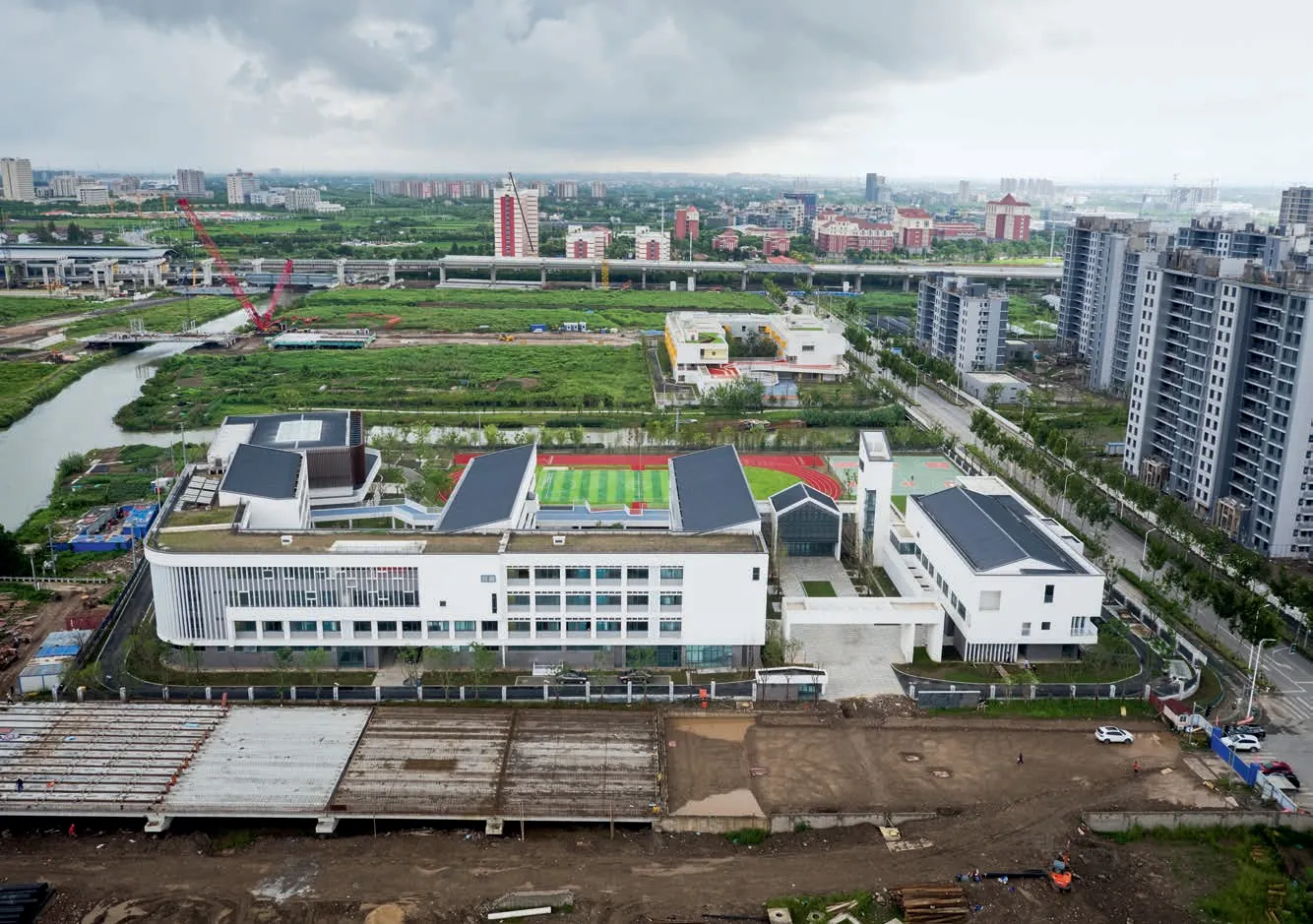
12 西侧鸟瞰/West aerial view(摄影/Photo: 陈颢/CHEN Hao)

